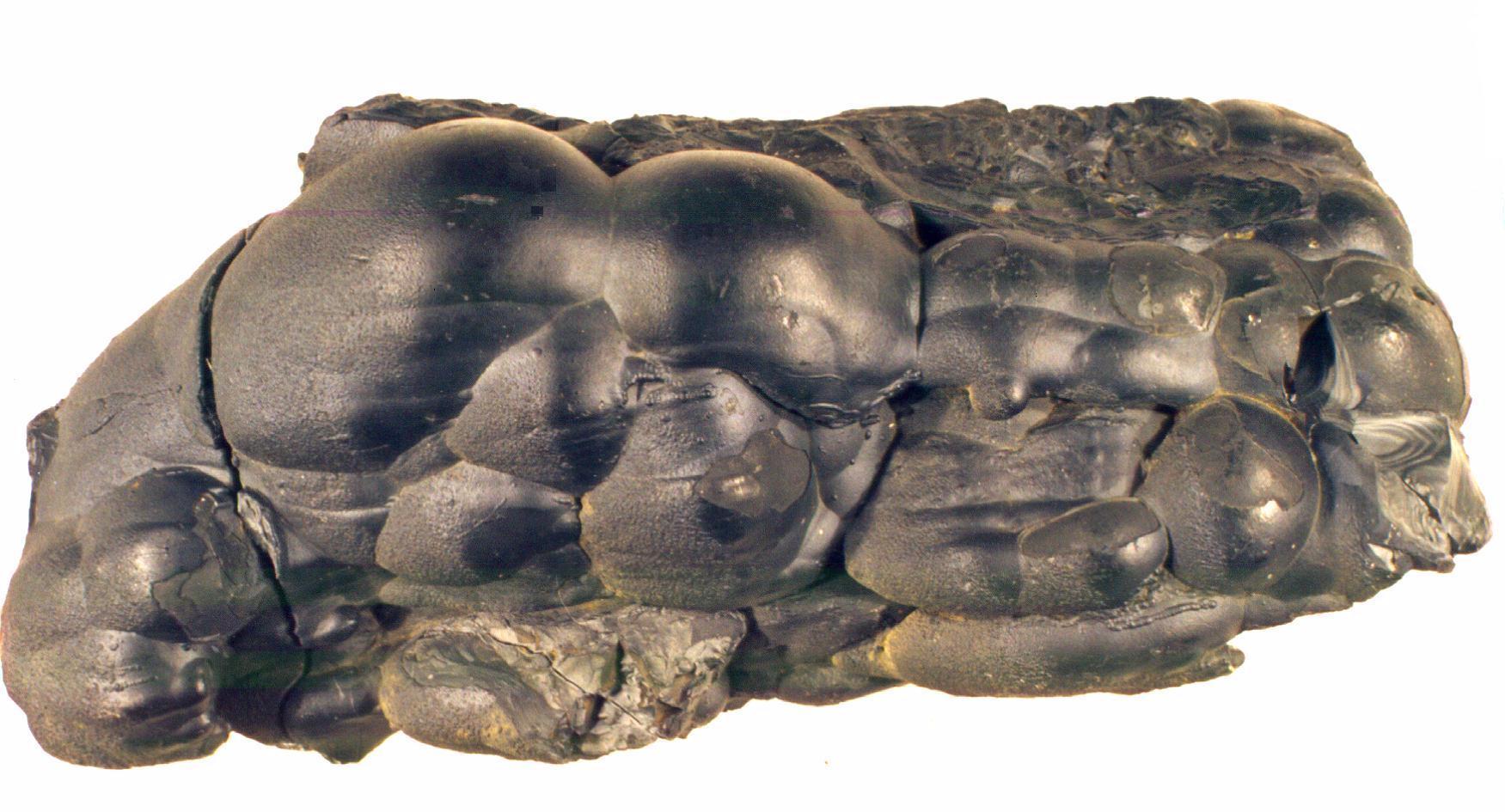(
Fr- psilomélane;
Ger- Psilomelan; Nor- psilomelan; Rus- ![]() )
)
PSILOMELANE ("may
be used for hard
unidentified [as to species] Mn oxides" per
CNMMN
of IMA even though name has been
discredited so far as application to any
mineral species)

Psilomelane. Labeled as "Cryptomelane, " this nodule (greatest dimension ~35 cm) is from now abandoned Crimora mine, Augusta County, Virginia. Michaels Museum collection (VPI&SU, Blacksburg, Virgina). (photo by Mark Fortney)
DESCRIPTION: As
noted in the subheading of this entry, psilomelane is widely used as a
waste-basket term
for
masses
made up largely or wholly of hard, massive manganese oxides not
specifically
identified -- See also paragraph three under the REMARKS
subheading.
Color - black to silvery black.
H. 5 - 6½
-- Possible Mn-mineral components noted in the
REMARKS
have recorded values ranging from 2 to 6½.
S.G. 4.3-4.8 --
Possible Mn-mineral components noted in the REMARKS have recorded values ranging from 4.3 to
5.44.
Light transmission - opaque
Luster - dull, velvety (on fresh fracture
surfaces),
submetallic
Miscellany - botryoidal
masses or crusts are common; brownish black streak; soluble
in
concentrated HCl (hydrochloric acid), releasing chlorine gas with its
distinctive ordor; some psilomelane is said to feel like velvet
-- although some fresh surfaces have a velvety appearance, I have not
encountered any that felt
like velvet.
Because of the preceding
statement, Ashley Bradford (p.c. -- email, 1 Nov.2011 --)
directed my attention to photographs of a specimen from Socorro County,
New Mexico that exhibit a surface that has such a "feel." She
indicates it feels "very
much like a chenille sweater. Not quite as soft as Cashmere, but that's
possibly just due to how short the "pile" is and the fact that there's
a very hard surface [beneath it]." I find this especially
interesting because the Greek ψιλόϛ
from which the Psilo
part of the name originally given to this "mineral'
means smooth or bald, whereas the presence of a "pile" atop the
typically smooth surfaces of this "mineral" are apparently required to
account for the velvetlike "feel."
OTHER NAMES:
USES: So far as a gemrock, uses similar to those for hematite and with the same limitations, which relate to its relatively high specific gravity. "Drusy psilomelane," in particular, has been used for brooches and pendants (especially wire-wrapped ones); spheres.
OCCURRENCES: As a weathering product, typically as botryoidal masses, in unconsolidated deposits -- e.g., residual clays.
NOTEWORTHY LOCALITIES: Schneeberg (Saxony), Germany; near Thumb Butte in the Palo Verde Mountains, Imperial County and at the Arlington mine, northwest of Blythe, Riverside County, California; the Soccoro Valley, New Mexico; the abandoned Crimora mine, Augusta County, Virginia.
REMARKS: Psilomelane comes from the Greek ψιλόϛ (smooth) and μέλαν (black). The first use of this term, according to OED notes that ".The name psilomelane...is formed in allusion to the black colour and smooth hematitic shapes of the mineral." The hematitic shapes apparently refer to the common botryoidal (shaped like a bunch of grapes) hematite -- see Figure C in HEMATITE entry as well as illustration in this entry.To confuse the issue further, in
the “lapidary world,” the term psilomelane is
frequently misapplied to psilomelane
chalcedony and even to moss agate that includes relatively abundant
black
dendritic inclusions. The latter misuse, fortunately more-or-less
restricted to the
marketplace,
is apparently based on the fact that many black dendrites have been
identified
as Mn-oxide(s). And, to confound the confusion, the nabisco term
psilodendrites
(apparently meant to suggest that the dendrites consisting of
psilomelane) is also referred to
dendrite-bearing/coated rocks such as quartzites that have been
fashioned into jewelry or even exhibited as display
specimens.(www-2.cs.cmu.edu)
SIMULANT:
Especially in the past, psilomelane
has been used as a substitute for hematite
in jewelry. - [Inferior specific
gravity. Powder is black.].
REFERENCES: No general reference. Milch,1994; Potter and Rossmann,1979 &1979A.
R. V. Dietrich © 2015
Last
update: 3 November 2011
web page created by Emmett Mason